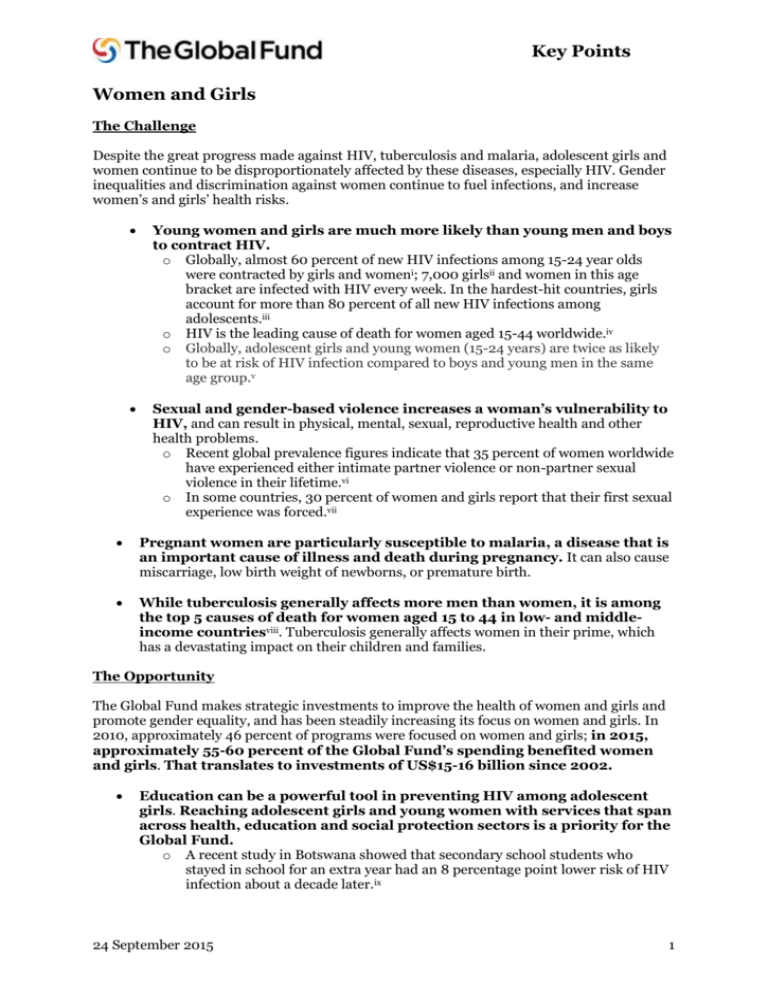
Key Points
Women and Girls
The Challenge
Despite the great progress made against HIV, tuberculosis and malaria, adolescent girls and
women continue to be disproportionately affected by these diseases, especially HIV. Gender
inequalities and discrimination against women continue to fuel infections, and increase
women’s and girls’ health risks.
Young women and girls are much more likely than young men and boys
to contract HIV.
o Globally, almost 60 percent of new HIV infections among 15-24 year olds
were contracted by girls and womeni; 7,000 girlsii and women in this age
bracket are infected with HIV every week. In the hardest-hit countries, girls
account for more than 80 percent of all new HIV infections among
adolescents.iii
o HIV is the leading cause of death for women aged 15-44 worldwide.iv
o Globally, adolescent girls and young women (15-24 years) are twice as likely
to be at risk of HIV infection compared to boys and young men in the same
age group.v
Sexual and gender-based violence increases a woman’s vulnerability to
HIV, and can result in physical, mental, sexual, reproductive health and other
health problems.
o Recent global prevalence figures indicate that 35 percent of women worldwide
have experienced either intimate partner violence or non-partner sexual
violence in their lifetime.vi
o In some countries, 30 percent of women and girls report that their first sexual
experience was forced.vii
Pregnant women are particularly susceptible to malaria, a disease that is
an important cause of illness and death during pregnancy. It can also cause
miscarriage, low birth weight of newborns, or premature birth.
While tuberculosis generally affects more men than women, it is among
the top 5 causes of death for women aged 15 to 44 in low- and middleincome countriesviii. Tuberculosis generally affects women in their prime, which
has a devastating impact on their children and families.
The Opportunity
The Global Fund makes strategic investments to improve the health of women and girls and
promote gender equality, and has been steadily increasing its focus on women and girls. In
2010, approximately 46 percent of programs were focused on women and girls; in 2015,
approximately 55-60 percent of the Global Fund’s spending benefited women
and girls. That translates to investments of US$15-16 billion since 2002.
Education can be a powerful tool in preventing HIV among adolescent
girls. Reaching adolescent girls and young women with services that span
across health, education and social protection sectors is a priority for the
Global Fund.
o A recent study in Botswana showed that secondary school students who
stayed in school for an extra year had an 8 percentage point lower risk of HIV
infection about a decade later.ix
24 September 2015
1
Key Points
o
For sustainable impact, the Global Fund partnership is exploring investments
to keep adolescent girls and young women in school and HIV-free. Keeping
adolescent girls and young women in school not only reduces their
vulnerabilities to HIV infection but has the potential to create a critical mass
of healthy, educated and financially independent women who make wellinformed choices about their lives.
Global Fund investments are reducing the number of AIDS-related
deaths among women and girls. Between 2005 and 2014, across 13 high-burden
African countries that the Global Fund invests in, there was a 58 percent decline in
AIDS-related deaths among women of 15 years and older, and each year, the number
of women dying of AIDS-related deaths declined twice as fast as that of men.
Global Fund investments are reducing the number of new HIV infections
among women and girls. In 11 high-burden countries in Africa, Global Fundsupported programs have led to a 23 percent decline in infections among women
between 2005 and 2014.
The Global Fund promotes gender equality and tailors its programs to
the needs and rights of women and girls. Through Global Fund investments,
more women are taking part in design and implementation of programs in their
communities. At the country level, 39.2 percent of decision-makers in Global Fund
grant committees are women.
To improve maternal, adolescent and child health, the Global Fund
supports programs that prevent the transmission of HIV from mothers to
their babies. Global Fund investments have put 3.1 million women on treatment to
prevent transmission of HIV to their unborn babies.
The Global Fund works with communities to ensure young children and
pregnant women in particular are protected by mosquito nets. More than
548 mosquito nets have been distributed through Global Fund-supported programs.
Additional Resources
Global Fund Gender Equality Strategy
(http://www.theglobalfund.org/documents/core/strategies/Core_GenderEquality_S
trategy_en)
Global Fund Gender Equality Strategy Action Plan
(http://www.theglobalfund.org/documents/publications/other/Publication_Gender
EqualityStrategy_ActionPlan_en)
Maximizing the Impact of Global Fund investments by Improving the Health of
Women and Children
(http://www.theglobalfund.org/documents/publications/other/Publication_IERG20
15_Report_en)
Global Fund Results Report 2015 -- http://bit.ly/1iIaGkK
24 September 2015
2
Key Points
i
ii
UNAIDS - http://bit.ly/11HIK7A
UNAIDS - http://data.unaids.org/GCWA/gcwa_bg_prevention_en.pdf
iii
Center for Strategic and International Studies -- http://bit.ly/1GQt701
WHO - http://www.who.int/mediacentre/factsheets/fs334/en/
v WHO - http://www.who.int/mediacentre/factsheets/fs334/en/
vi WHO - http://www.who.int/mediacentre/factsheets/fs239/en/
vii WHO - http://www.who.int/mediacentre/factsheets/fs239/en/
viii WHO -http://www.who.int/mediacentre/factsheets/fs104/en/
ix The Lancet - http://www.sciencedirect.com/science/article/pii/S2214109X1500087X
iv
24 September 2015
3




